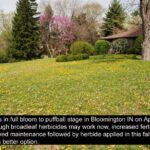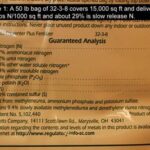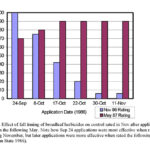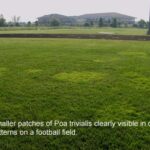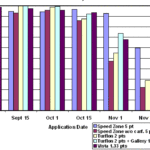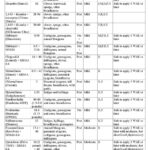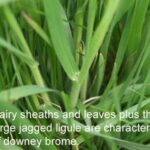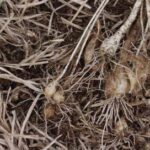Category: Weed Control
For professionals: Spring dandelion control
Now that dandelions are flowering or in the puffball stage throughout IN, now is the second best time to control these weeds. Fall applications are still most effective for controlling broadleaf weeds. It does not take much wind to drift and damage off- target ornamentals, gardens, and trees. Choosing low-volatile formulations should reduce the chances […]
For professionals: Where’s Tenacity Herbicide for Lawns?
Tenacity herbicide (mesotrione) is from Syngenta and it will selectively control crabgrass, creeping bentgrass, nimblewill, and a number of broadleaf weeds in cool-season lawns. It is one of the most unique and effective herbicides that we have tested in a long time. Though it was labeled early in 2008 for golf course and sod farm […]
For Professionals: Herbicide Delays after Seeding
Many turf areas required dormant seeding or seeding this spring to help repair damage from last summer and fall. Weed germination is just around the corner and may be problematic on thin turf. Almost all herbicides will affect turfgrass seedlings and application delays are usually needed following seeding. Following is information gleaned from available labels […]
For professionals: Seed thin turf now or use weed control?
With last year’s brutal summer and early fall, many areas are in need of reseeding. The question comes up about seeding and weed control: should the weeds be controlled first or should the seeding be done first? This seems like a simple question, but it’s fairly complex depending on the turf and weed species present […]
Do it yourself: Choose preemergence herbicides with as little N as possible: Part II
Per the earlier Turf Tip, select preemergence herbicides with as little nitrogen as possible to reduce the growth flush and maximize long-term health of the plant. The problem is finding a product with little or no N. Do not make the mistake of settling for a high N product and then reducing the application rate. […]
For Professionals: Choosing a Preemergence Herbicide
There are many, many formulations and combinations of preemergence herbicides available for the professional. Following are some suggestions for purchasing and using preemergence herbicides. Control from every preemergence herbicide can vary from year to year, or location to location. Therefore, you can’t judge the performance of a product or a specific rate of that product […]
For Professionals: Timing of Preemergence Herbicides
If a preemergence herbicide is justified on a turf area, the timing of application is important. In theory, applying too early will expose the herbicide to soil microbes and processes in the soil that may break it down, allowing crabgrass to germinate during the latter part of the summer. Conversely, applying too late may miss […]
Choose Preemergence herbicides with as Little N as Possible
If a preemergence herbicide is justified on your lawn to control crabgrass now, most of those are available combined with fertilizer and you are forced to apply a fertilizer now. Look for a product with low nitrogen and be sure the majority of the nitrogen is a slow release N. Slow release sources include sulfur- […]
How Late is Too Late to Control Dandelions and Other Weeds?
Even though the drought has limited some broadleaf weed applications this month, we are now in the prime season for broadleaf weed control. Actually there is plenty of time left for good control. Nebraska research reported in 2002 showed 2,4-D and/or dicamba were far more effective in controlling dandelions and Canada thistle when applied 1 […]
Preemergence herbicides starting to break in hot spots
Crabgrass is starting to breakthrough in hotspots next to walks and drives, southern exposures, and in thin turf. Though many are quick to question the effectiveness of the specific preemergence herbicide used last spring, the vast majority of the breakthrough is due to weather, environment, or application techniques. Our research plots this year are showing […]
White Clover in Golf Courses, Sports Turf, and Lawns
The small white flowers of white clover are very visible right now and it may appear that clover is taking over, especially under-fertilized turf areas. Clover is a legume and is very competitive under low N conditions, so increasing annual N is the best method for long-term control. The temptation is to apply a herbicide […]
Crabgrass and Yellow Nutsedge
Crabgrass and yellow nutsedge are really starting to flourish. Unfortunately, our options for control of either weed are becoming limited. Plus the hot temperatures increase the risk for turf damage with any herbicide applied now. The best current option for crabgrass is quinclorac (Drive or Quinclorac), which has the best activity among all the post […]
Controlling Poa trivialis in sports fields
Poa trivialis is now common in sports fields, possibly due to as little as one contaminated seed source from the many overseedings done on sports fields. Once germinated, Poa trivialis spreads via stolons which may be further spread during every hollow tine aerification. Poa trivialis is shallow rooted, has poor wear resistance, is extremely susceptible to dollar spot, and often […]
Controlling ground ivy and/or violets
Ground ivy and violets are currently flowering and at their peak of beauty, but these two weeds remain tough to control in Indiana . Like almost all broadleaf weeds, flowering indicates a point in their lifecycle where they are susceptible to herbicide application. Even though applications now can produce visible damage, long-term control does not […]
Weed Control in Newly Seeded Bermudagrass
Bermudagrass seeded or sprigged into damaged areas will require weed control to maximize establishment. Most herbicides carry precautions on use in sprigged bermudagrass, but few carry recommendations on use in seeded bermudagrass because of the newness of seeded varieties. Following is a table of herbicide recommendations gleaned from the latest research on seeded bermudagrass. Herbicides […]
Spring Dandelion Control for Professionals
Though fall applications are most effective for controlling broadleaf weeds, spring applications are warranted for many turf areas. Now that dandelions are blooming or in the puffball stage throughout IN, applications should be effective. It does not take much wind to drift and damage off- target ornamentals, gardens, and trees. Amines tend to be less […]
Time to Switch Crabgrass Control Strategies
Crabgrass is starting to germinate throughout much of the state and thus preemergence herbicides will be of limited effectiveness. Though some will report burn-back of very small crabgrass with a strictly preemergence application, combining a preemergence with a postemergence herbicide will be most effective for the next two months. The postemergence herbicide will control that […]
Downy brome growing fast and furious in turf stands
The winter annual downy brome is growing aggressively in turf stands currently, almost twice as fast as the desired Kentucky bluegrass or tall fescue (photo). Downey brome is fairly easily identified at this time of the year by its hairy leaves and sheaths and it has a split collar with jagged membranous ligule (photo). It […]
Controlling Wild Onion or Wild Garlic
Wild onion and wild garlic are now fully emerged throughout the state of Indiana and these are two of the more difficult to control weeds. Like the garden varieties, these plants are edible and similar looking, except the stems of the wild type are much thinner and do not grow as tall as the garden […]
Do-It-Yourselfer: Is it Crabgrass or Tall Fescue?
We have received a number of calls this year about trying to control the crabgrass running rampant in lawns. It’s a much more coarse bladed and lighter green than the rest of the grass, so it must be crabgrass? It’s not crabgrass and is more likely tall fescue. Though crabgrass and tall fescue may look […]
